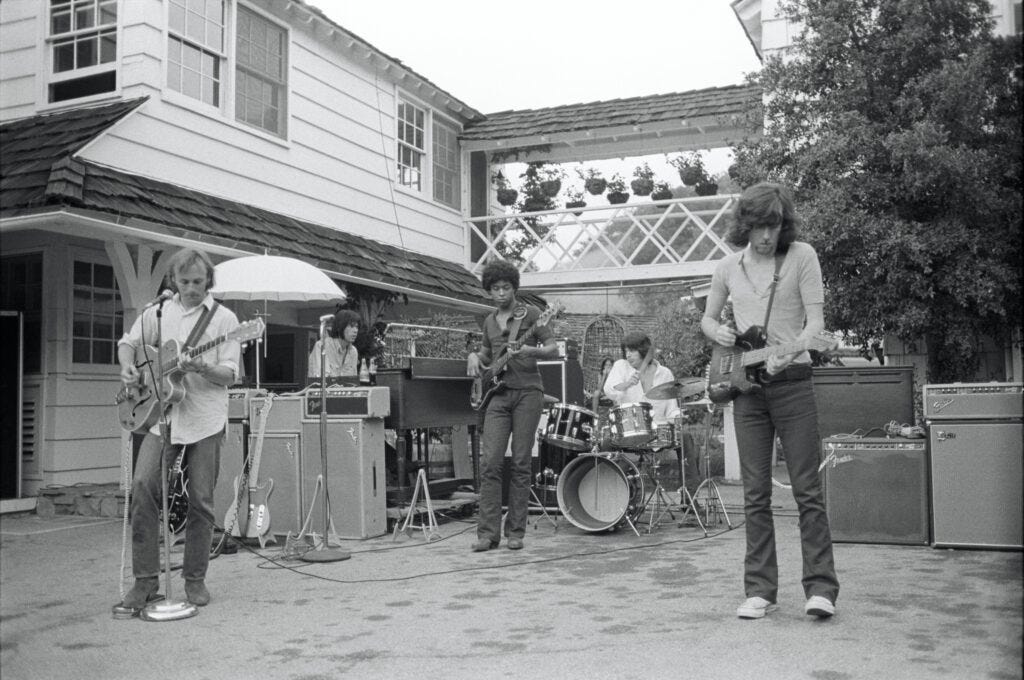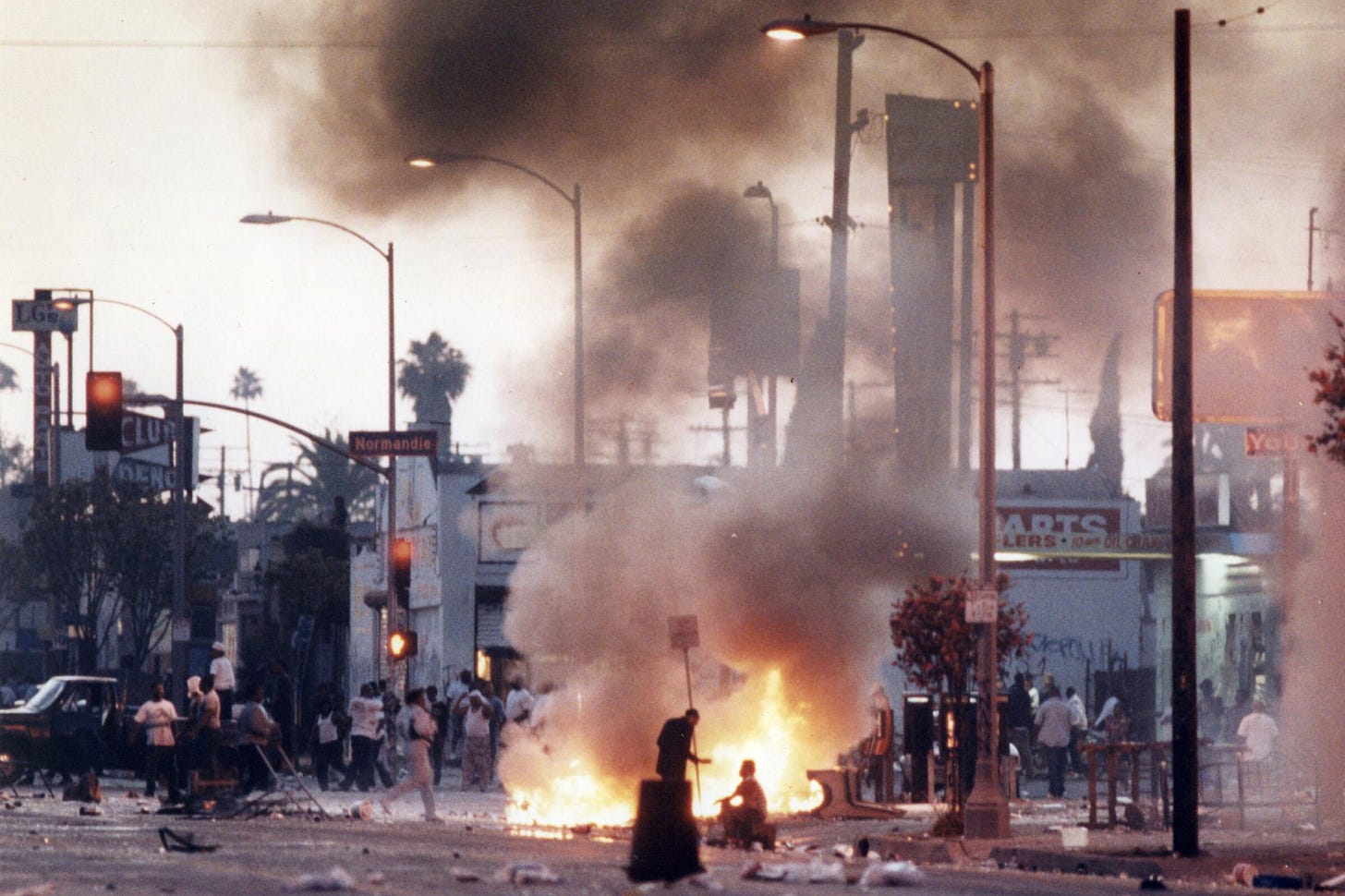Introduction
Beneath the noise of traffic and the shadow of billboards, Los Angeles tells its story through art and sound. The real soul of the city lives in the soundscape of its neighborhoods. Los Angeles has long been shaped by its cultural expressions, from murals tucked into neighborhood streets to local music scenes that come alive in backyards and community spaces. Local music genres, like Laurel Canyon folkrock and West Coast rap have long worked together to tell the stories that often go unheard in Los Angeles. These are more than just creative outlets. They’re historical records, shaped by migration, resistance, and community. It isn’t the celebrities walking the streets or the overpriced matcha lattes at every corner that define the culture of Los Angeles; instead it is these works of art and protest that have made LA feel alive.
Laurel Canyon: The Sound of a Counterculture
In the 1960s and '70s, Laurel Canyon gave rise to a new sub-genre known as Folk rock. Tucked into the Hollywood Hills, the more rustic neighborhood of Laurel Canyon became a creative haven for artists like Joni Mitchell, The Byrds, and Crosby, Stills, Nash & Young.1 The neighborhood became a place where musicians lived, wrote, and recorded together, blending folk, rock, and psychedelic sounds into what became known as the “California Sound.”2 Influenced by the civil rights movement, antiwar protests, and a desire for more honest artistic expression, Laurel Canyon artists began reimagining folk music for a restless new generation.
Folkrock Music in Laurel Canyon
A defining moment came in 1965, when The Byrds released their electrified cover of Bob Dylan’s “Mr. Tambourine Man.”3 While Dylan wrote the lyrics, it was the Laurel Canyon sound consisting of electric guitars, harmonies, and a steady backbeat that made the song an anthem of youthful searching and unrest.4 In fact, the Van Nuys News wrote that “Mr. Tambourine Man became one of the nation’s best sellers in its first month of release.”5 Folkrock in L.A. became more than a genre. It captured a moment, mixing social commentary with the experimental spirit of the West Coast.
The Byrds - Mr. Tambourine Man
West Coast Rap: Voices from Compton
Fast forward to the late 1980s, and Los Angeles had become the center of a new kind of protest music: louder, angrier, and more direct than anything that came before. Out of Compton, a neighborhood marked by over-policing and economic inequality, emerged N.W.A., a rap group made up of Eazy-E, Dr. Dre, Ice Cube, MC Ren, and DJ Yella.6 With the release of Straight Outta Compton in 1988, they became the voice at the center of a growing movement in West Coast hip-hop.7 With tracks like “F*** tha Police,” N.W.A. didn’t just make music; they documented lived experience. Their lyrics laid bare the everyday reality of police harassment, surveillance, and brutality in Black neighborhoods.8 Told as a mock courtroom trial, the song casts Dr. Dre as judge while Ice Cube, MC Ren, and Eazy-E deliver blistering testimonies against the Los Angeles Police Department. The lyrics accuse police of targeting Black youth, using excessive force, and operating with impunity.
got it bad 'cause I'm brown
And not the other color so police think
They have the authority to kill a minority
F*** that shit, 'cause I ain't the one
N.W.A. “Straight Outta Compton” Album Cover
In a 1990 BBC interview, Ice Cube explained the motivation behind the song: “I was tired of seeing my friends come home with scars... police beating them up for anything and everything. So I was like, ‘Let’s retaliate in song. You can’t do it physically, but we can hurt their feelings on this record.’”9
The backlash was immediate. In 1989, FBI assistant director Milt Ahlerich, issued a letter to NWA's record label stating that the song "encourages violence against and disrespect for the law enforcement officer.”10 The letter read “violent crime, a major problem in our country, reached an unprecedented high in 1988. Seventy-eight law enforcement officers were feloniously slain in the line of duty during 1988, four more than in 1987.”11 But what it didn’t mention? The growing number of young Black men dying in police custody, or the daily harassment so many were facing in cities like Los Angeles.12 But instead of silencing the group, the controversy only made their message louder.13 Just a few years later, in 1992, after the acquittal of four white LAPD officers who were caught on video brutally beating Rodney King, “F*** tha Police” became an unofficial anthem of the uprising that followed.14
1992 Los Angeles Riots
This era of West Coast rap carved out a new cultural space in the city, one that reflected the frustrations and realities of communities often left out of mainstream narratives. It helped redefine Los Angeles not just as a center of entertainment, but as a place where music could be political, local, and deeply tied to the lived experiences of its people.
The Lasting Power of Protest Music in Los Angeles
Protest music has never really disappeared from Los Angeles. It has evolved. From the folk rock music floating out of Laurel Canyon in the '60s to the rawness of West Coast rap in the late ’80s, L.A. artists have consistently used music as a tool to document struggle, question power, and imagine something better. Today, that tradition lives on in artists like Kendrick Lamar, who was born and raise in Compton Los Angeles. His albums To Pimp a Butterfly and DAMN. confront issues of racial injustice, identity, and systemic inequality with the same intensity that defined N.W.A.’s early works. Protest music in Los Angeles is more than just a genre. This music is a part of the city’s cultural foundation, rooted in place and community.
Kendrick Lamar Performance in Los Angeles
Conclusion: Seeing Los Angeles Through a New Lens
Before this project, I always saw Los Angeles as a city of progress: diverse, creative, forward-looking. I grew up believing it was a place where people came to build new lives and chase opportunity. But learning about the parts of its history that don’t get talked about as often has complicated that view. I learned about the Chumash people, who lived on this land long before it was called California, and how their communities were disrupted and nearly destroyed by colonization. I read about the 1871 Chinese Massacre in downtown Los Angeles, where a racist mob killed nearly twenty Chinese men in one of the worst acts of anti-Asian violence in U.S. history, something I had never been taught in school. And I spent time tracing the legacy of slavery, segregation, and civil rights struggles right here in this city. It was disheartening to realize how much of this history has been ignored or erased. At the same time, learning about it has made me feel more connected to L.A. in a deeper, more grounded way. It’s made me realize that understanding where we are means understanding what came before us. This yearlong project has ultimately helped me understand that loving a city doesn’t mean overlooking its flaws; it means being willing to see them clearly and recognize them.
Lisa Robinson, "An Oral History of Laurel Canyon, the 60s and 70s Music Mecca," Vanityfair.com, last modified February 8, 2015, accessed May 19, 2025, https://www.vanityfair.com/culture/2015/02/laurel-canyon-music-scene?srsltid=AfmBOooMM5PCQnmr8Q9L6JN7xagqhfDFl5oIS-w6ZDaD5lBUn-sUvf8P.
Nrgrecording.com, last modified August 7, 2017, accessed May 19, 2025, https://www.nrgrecording.com/post/50-years-of-los-angeles-music-culture.
Nrgrecording.com.
Nrgrecording.com.
"Byrds Top Shows," The Van Nuys News (Los Angeles, CA), August 20, 1965, 14, Basic.newspapers.com.
Greg McKevitt, "'It's Time to Retaliate in Song' – Why NWA's Provocative 80s Rap Became an Anthem," Bbc.com, last modified August 5, 2024, accessed May 19, 2025, https://www.bbc.com/culture/article/20240802-the-nwa-protest-anthem-that-foreshadowed-riots-in-the-us.
Theresa A. Martinez, "Popular Culture as Oppositional Culture: Rap as Resistance," Sociological Perspectives 40, no. 2 (1997): 12, https://doi.org/10.2307/1389525.
Martinez, "Popular Culture," 12.
"Ice Cube – ABC Interview (1990)," video, 05:11, Blackouthiphop.com, posted May 29, 2020, accessed May 19, 2025, https://blackouthiphop.com/blog/ice-cube-abc-interview-1990/.
McKevitt, "'It's Time," Bbc.com.
Jack Whatley, "The Threatening Letter the FBI Sent to N.W.A.," Hiphophero.com, last modified October 27, 2021, accessed May 19, 2025, https://hiphophero.com/the-threatening-letter-the-fbi-sent-to-n-w-a/.
Whatley, "The Threatening," Hiphophero.com.
McKevitt, "'It's Time," Bbc.com.
McKevitt, "'It's Time," Bbc.com.
Bibliography
"Ice Cube – ABC Interview (1990)." Video, 05:11. Blackouthiphop.com. Posted May 29, 2020. Accessed May 19, 2025. https://blackouthiphop.com/blog/ice-cube-abc-interview-1990/.
Martinez, Theresa A. "JSTOR Popular Culture as Oppositional Culture: Rap as Resistance." Sociological Perspectives 40, no. 2 (1997): 265-86. https://doi.org/10.2307/1389525.
McKevitt, Greg. "'It's Time to Retaliate in Song' – Why NWA's Provocative 80s Rap Became an Anthem." Bbc.com. Last modified August 5, 2024. Accessed May 19, 2025. https://www.bbc.com/culture/article/20240802-the-nwa-protest-anthem-that-foreshadowed-riots-in-the-us.
Nrgrecording.com. Last modified August 7, 2017. Accessed May 19, 2025. https://www.nrgrecording.com/post/50-years-of-los-angeles-music-culture.
Robinson, Lisa. "An Oral History of Laurel Canyon, the 60s and 70s Music Mecca." Vanityfair.com. Last modified February 8, 2015. Accessed May 19, 2025. https://www.vanityfair.com/culture/2015/02/laurel-canyon-music-scene?srsltid=AfmBOooMM5PCQnmr8Q9L6JN7xagqhfDFl5oIS-w6ZDaD5lBUn-sUvf8P.
The Van Nuys News (Los Angeles, CA). "Byrds Top Shows." August 20, 1965. Basic.newspapers.com.
Whatley, Jack. "The Threatening Letter the FBI Sent to N.W.A." Hiphophero.com. Last modified October 27, 2021. Accessed May 19, 2025. https://hiphophero.com/the-threatening-letter-the-fbi-sent-to-n-w-a/.
Images:
https://medium.com/california-dreaming/music-in-the-canyon-923b46b0b7cd
https://mg.co.za/article/2015-08-18-how-nwa-came-straight-outta-compton-and-went-mainstream/
https://www.latimes.com/california/story/2022-04-27/full-coverage-30-years-since-the-1992-la-riots
https://www.npr.org/2024/06/20/g-s1-5357/kendrick-lamar-juneteenth-concert-west-coast








